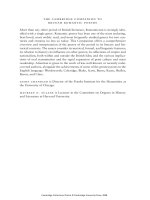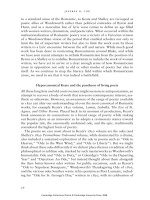The cambridge companion to british roman 48
Bạn đang xem bản rút gọn của tài liệu. Xem và tải ngay bản đầy đủ của tài liệu tại đây (45.88 KB, 1 trang )
j e f f r e y n . c ox
to a standard sense of the Romantic, as Keats and Shelley are recouped as
poetic allies of Wordsworth rather than political comrades of Byron and
Hunt, and as a masculine line of lyric verse comes to define an age filled
with women writers, dramatists, and poetic tales. What occurred within the
institutionalization of Romantic poetry was a victory of a Victorian version
of a Wordsworthian vision of the period that enabled scholars not only to
limit the list of important writers but also to limit the work even by those
writers to a lyric encounter between the self and nature. While much good
work has been done in reorienting Romanticism around Blake, and while
we have seen recent attempts to rethink Romanticism from the position of a
Byron or a Shelley or to redefine Romanticism to include the work of women
writers, we have yet to arrive at a clear enough sense of how Romanticism
arose in opposition not only to old or other modes of poetry but also to
itself. As we continue to map the literary field within which Romanticism
arose, we need to see that it was indeed a battlefield.
Hypercanonical Keats and the pantheon of living poets
All these long lists and old controversies might seem mere antiquarianism, an
attempt to recover a body of work that serves no contemporary interest, aesthetic or otherwise. However, an awareness of the range of poetry available
in 1820 can alter our understanding of even the most canonical of Romantic
works, for example Keats’s 1820 volume, Lamia, Isabella, The Eve of St.
Agnes, and Other Poems. Placed back in its moment of production, Keats’s
book announces its connections to a broad range of poetry while staking
out Keats’s place as an innovator as he adopts a revisionary stance toward
the popular tale, the canonically enshrined ode, and the epic, traditionally
considered the highest form of poetry.
The poems we care most about in Keats’s 1820 volume are the odes (and
Shelley’s 1820 Prometheus Unbound volume, while dominated by a drama,
also included a sustained exploration of the ode in poems such as “Ode to
Heaven,” “Ode to the West Wind,” and “Ode to Liberty”). But we might
think about these odes differently if we did not place them in a tradition of the
philosophical or sublime ode, marked by such masterworks as Wordsworth’s
Immortality Ode and “Ode to Duty,” or Coleridge’s “Ode to the Departing
Year” and “Dejection: An Ode,” but instead thought about them alongside
the then better-known odes written for public occasions, such as Byron’s
“Ode to Napoleon Bonaparte,” Wordsworth’s Thanksgiving Ode of 1816,
and the various odes Southey wrote in his position as Poet Laureate, including his “Ode for St. George’s Day,” written in 1820, with its celebration of
26
Cambridge Collections Online © Cambridge University Press, 2008









